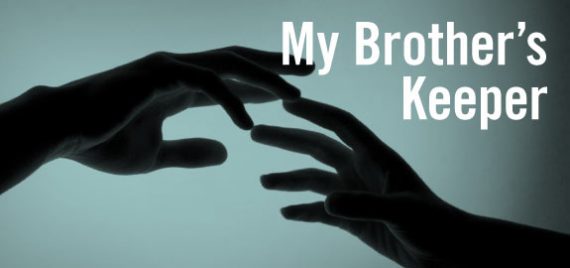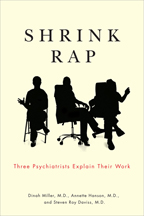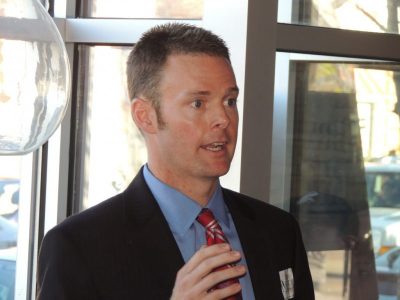
(1-22-18) The writer of this letter is a veteran police officer in a major city who emailed me after reading my book, CRAZY: A Father’s Search Through America’s Mental Health Madness.
Dear Pete,
I have a mentally ill older brother named Tom.*
He’s been sick since he was 18, and while reading your book, I immediately felt a bond with you and your son, Kevin. My brother’s story is not much different from your son’s.
Tom is/was a very bright individual, probably smarter than me, but at age 18, he was with his girlfriend and another individual smoking pot when he had a traumatic episode. He was rushed to the hospital and doctors didn’t know what was wrong with him. Over the course of the next several months, he became worse and worse and my parents didn’t know what to do. His brain was failing him and he began hearing voices. He told us God was speaking to him, as well as Jim Morrison from the Doors.
I was still very young when this was occurring, I would guess 1984/1985? I was just 12 or 13 and my older brother was diagnosed as having schizophrenia. My parents, as well as my younger sister and I didn’t know how deal with this.
Tom was completely out of his mind!
I remember my brother being sent to a state hospital.
My parents and I visited him there and I recall the dismal conditions. I was absolutely horrified seeing the other individuals my brother was being housed with. One Flew Over the Cuckoo’s Nest would be the best comparison.
When you wrote in your book about the 9th floor of the Miami Dade jail, I kept having flashbacks of how ill the people in my brother’s hospital were – catatonic, drooling on themselves, others talking to the walls. As a young teenager, I began to cry, wondering why my brother was in this place. He couldn’t be this bad, could he?
Eventually, my brother was released and allowed to come home. The years that followed were absolutely brutal for my family. Doctors didn’t know what medicines to give my brother, essentially, he became a guinea pig, throwing everything they could at him to try and stabilize his brain.
My brother was bounced around from halfway house to halfway house, always running into trouble.
Trouble just seemed to find him.
People would ask him to buy them booze, drugs, etc. and he would always be taken advantage of. Ultimately, he ended up back at home and still lives with my parents to this day. His medicine seems to be stable now and he’s able to function day-to-day, however, every couple of years I will get a call from my police department stating that they have my brother and want to know what they should do with him.
Each time, I explain that he is sick and request that they wait for me to come get him. The officers have been pretty good at letting me take him back home. When he’s on his meds, he’s pretty good, some people don’t even know he’s ill. When he’s off his meds he’s “bark at the moon batshit crazy”. Thankfully, my parents watch over him very closely and get him back on track.
Unfortunately, my parents are getting up there in age and won’t always be around to take care of him. I’ve assured them that I will always make sure he has a safe place to live and I won’t let him live on the streets. Your book terrified me with the stories of the subjects living on the streets and being beaten, taken advantage of, and wandering around like lost souls.
I can’t have that happening to my brother.
I think every law enforcement officer in the country should be required to read your book. When I was a young patrol officer I almost shot a mentally ill subject who was wielding a knife. It happened about 15 years ago when my partner and I were called to a disturbance at an apartment complex. As we arrived, a young male and female came running down the stairs exclaiming, “He’s up there, he has a knife!”
They told us their friend was suicidal and was acting irrational. We asked if anyone else was in the apartment and the two replied they were not sure. This kind of perplexed us because the apartment was rather small. At this point in my career, I had only six years on the department and was still fearless.
Generally, officers won’t enter a residence unless they can determine that other lives are in jeopardy.
If you have a single individual making threats, our procedure now is lock down the area, call it a barricade situation and call in our Special Assignments Unit. But when my partner and I rushed up to the 2nd floor apartment, we found the door open. As soon as we crossed the threshold, we were confronted by a young, white male, in his early 20’s, holding a large kitchen knife. We immediately drew our guns, which we pointed at the male, commanding him to “drop the knife.”
He said ‘No” and told us that he wanted to die.
My partner and I were stuck.
Here we were, guns drawn, in a tiny apartment, facing a distraught young man who was telling us he wanted to die.
“Suicide by cop.” I did not want to shoot this guy.
We warned him that if he took one step forward, we would be forced to fire but that was not how we wanted this emergency to play out. He was well within the lawful 21 foot ‘danger zone’ that we’d learned about at the academy. At that distance, a potential attacker could reach and stab you before you could draw your weapon and fire. We already had our guns drawn, but he was within 8 to 10 feet of us. We knew damn well that we could just shoot him and be justified.
My department had recently obtained tasers but only two or three officers, who were working on our shift, had them and neither was with us. We were still in a stand-off when our supervisor arrived. He remained outside the doorway, calling for a taser while we kept our guns aimed at this clearly unstable and suicidal suspect.
In these situations you are so focused that time often seems to slow down. We must have waited for 15 or 20 minutes for an officer with a taser to arrive.
Holding a person at gunpoint for that long, trying to negotiate with them, begging them to not take one step forward, can be very tiresome, both physically and mentally.
The taser equipped officer finally arrived and I could hear our team standing behind us outside the open door formulating a plan. In a purposeful move, the officer with the taser entered, stepped between us and fired.
It was a polyester dogpile after that. I remember trying to pull the knife away from him and when he was given another jolt, I was shocked by the electricity flowing through his body. I screamed in a high pitched squeal and my former supervisor still laughs to this day when he talks about me being shocked.
Thankfully, we were able to successfully subdue the subject and get him handcuffed. My partner and I put him in our patrol car and advised him that we were taking him to a mental facility. During the ride, he became calm and thanked us for not shooting him.
That’s right. He thanked us and acknowledged that he needed help and was very upset about something that I don’t even remember now. What I do remember is that I didn’t have to take his life.
I don’t know what happened to this individual, but what I do know is he was very lucky that my partner and I arrived that night. We didn’t join the police force to take lives. We joined to protect and serve them. Another officer might have simply shot the individual.
I would have been 100% justified in the shooting, but looking back, I would have felt absolutely terrible about it. He could have been my brother, your son Kevin, or some other mentally ill person who just needed proper medication and guidance.
*Tom is a pseudonym.





 “As a society, we simply must do a better job in addressing mental illness. Far too often, police, the sheriff and prosecutors are asked to be the primary treatment providers for the mentally ill, and it should be obvious that we have neither the expertise nor the resources to adequately address the myriad of issues raised by mentally ill citizens,” Porter told the newspaper.
“As a society, we simply must do a better job in addressing mental illness. Far too often, police, the sheriff and prosecutors are asked to be the primary treatment providers for the mentally ill, and it should be obvious that we have neither the expertise nor the resources to adequately address the myriad of issues raised by mentally ill citizens,” Porter told the newspaper.

